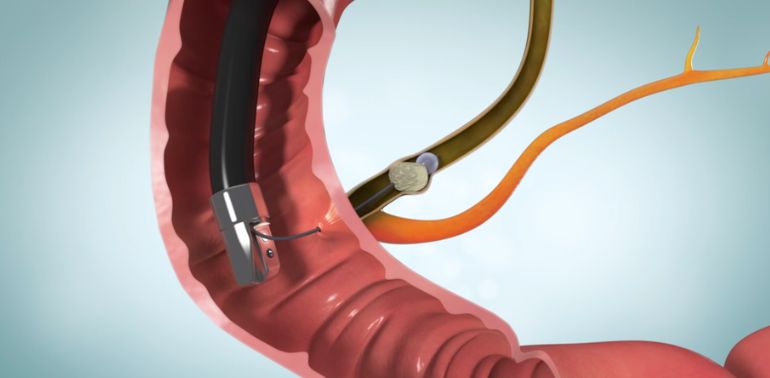
What is Endoscopic Retrograde Cholangiopancreatography (ERCP)?
Endoscopic Retrograde Cholangiopancreatography (ERCP) is a minimally invasive procedure that allows doctors to diagnose and treat problems in the bile ducts, pancreas, and gallbladder. ERCP combines the use of an endoscope (a flexible, tube-like instrument with a camera) with fluoroscopy (a type of X-ray) to obtain high-resolution images of these critical structures.
During the procedure, a catheter is inserted through the endoscope and into the bile or pancreatic ducts, allowing the physician to perform diagnostic imaging and, if needed, treatment—such as stone removal, stent placement, or biopsy.
ERCP is commonly used to identify and treat conditions such as:
- Bile duct blockages (due to stones, strictures, or tumors)
- Gallstones in the bile ducts
- Pancreatic disorders, such as pancreatitis or cancer
- Biliary leaks following surgery or trauma
- Narrowing of the bile ducts (strictures)
- Suspected pancreatic or bile duct cancer
How Does ERCP Work?
ERCP involves a series of steps that allow the gastroenterologist to visualize and address issues affecting the bile ducts, gallbladder, and pancreas. Here's a step-by-step breakdown of how the procedure works:
-
Preparation: Before the procedure, you will be asked to fast for several hours (usually 8–12 hours) to ensure that your stomach is empty. This is important for both safety and to ensure clear images. Your doctor will also review your medical history, including any medications you take.
-
Sedation: ERCP is typically performed under moderate sedation or light general anesthesia to ensure you are comfortable and relaxed during the procedure. You may feel drowsy and will not experience pain or discomfort, though you may be awake enough to respond to the doctor’s instructions.
-
Insertion of the Endoscope: The gastroenterologist inserts a thin, flexible tube called an endoscope through your mouth and guides it down into your esophagus, stomach, and into the duodenum (the first part of the small intestine). A small camera at the end of the endoscope provides a real-time view of the area.
-
Contrast Dye Injection: Once the endoscope is in place, a special contrast dye is injected into the bile or pancreatic ducts through a catheter that is passed through the endoscope. This dye allows the doctor to see the ducts clearly on X-ray images, which are taken in real time.
-
Diagnosis and Treatment: Based on the imaging, the gastroenterologist can diagnose conditions such as blockages, narrowing, or tumors in the bile or pancreatic ducts. If a treatment is needed, the doctor may perform one of the following procedures during the ERCP:
- Stone removal: Stones blocking the bile or pancreatic ducts can be removed using specialized tools.
- Stent placement: A small tube (stent) may be placed to open up a narrowed or blocked duct and restore proper flow of bile or pancreatic fluids.
- Dilation: A balloon can be used to widen a narrowed bile duct (stricture).
- Biopsy: A tissue sample may be taken for further examination if abnormal growths or tumors are detected.
-
Completion: After the procedure, the endoscope is carefully removed. You will be monitored for a short period until the sedation wears off. Most patients can go home the same day, although you will need someone to drive you.
Why is ERCP Performed?
ERCP is performed to diagnose and treat a variety of conditions affecting the bile ducts, pancreas, and gallbladder. Some common reasons for an ERCP include:
- Bile Duct Obstructions: When a blockage occurs in the bile ducts, often due to gallstones, tumors, or scarring, it can lead to symptoms like jaundice (yellowing of the skin and eyes), abdominal pain, and digestive problems.
- Gallstones: Gallstones can sometimes travel from the gallbladder into the bile ducts, causing blockages and pain. ERCP can be used to remove these stones.
- Pancreatitis: In cases of chronic or severe pancreatitis, ERCP can help by draining infected fluid or removing obstructions.
- Strictures: Narrowing of the bile ducts can occur due to injury, surgery, or inflammation. ERCP can help diagnose and treat strictures by inserting a stent or performing dilation.
- Suspected Pancreatic or Bile Duct Cancer: ERCP can help detect tumors in the bile or pancreatic ducts and may assist in diagnosing or staging cancer.
What to Expect Before, During, and After ERCP
Before the Procedure
- Preparation: You will be asked to fast for several hours before the procedure. This ensures your stomach is empty for both safety and clearer imaging.
- Medical Review: Your doctor will ask about your medical history, including any medications or allergies.
- Sedation: ERCP is performed under sedation, so you won't feel pain, but you may need to arrange for someone to drive you home afterward.
During the Procedure
- Endoscopy Insertion: The doctor will insert the endoscope through your mouth and guide it into the duodenum.
- Imaging: A contrast dye is injected into the bile or pancreatic ducts, followed by X-ray imaging.
- Therapeutic Interventions: Depending on the findings, the doctor may remove stones, place a stent, dilate a narrowed duct, or take a biopsy.

